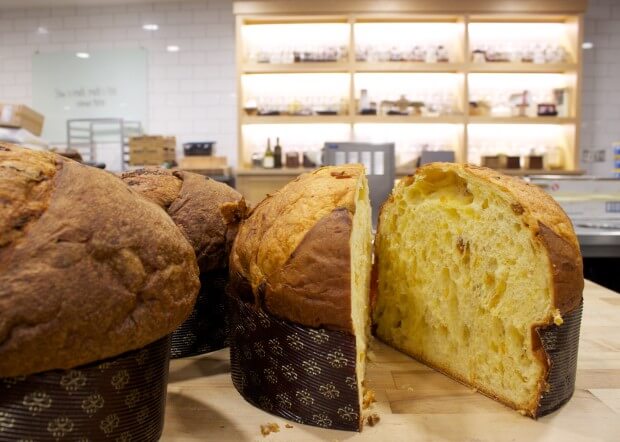Making the Perfect Panettone, the Everest of Holiday Baking
For every pastry chef developing a recipe, there comes a moment when the thing standing between perfection and total disaster finally steps into the light.
For pastry chef Matt Tinder, that moment came four years ago in the kitchen at San Francisco’s Coi, when he pulled his second loaf of panettone out of the oven, flipped it upside down to keep it from deflating, and watched it implode. The first had come out surprisingly well, but now with this one, three days of work lay in crumbs on the floor. He studied the uneven pockets of air in the underdone center, and it was abundantly clear. The thing gone wrong was the yeast.
Without extremely lively yeast, panettone is essentially a bad fruitcake—dense, sickeningly sweet, and not a pretty sight. And like bad fruitcake, loaves of bad panettone sit on many tables this time of year. But this is where the similarities end.
Technically, panettone is not a cake but a bread of leavened wheat flour blended with an extravagant amount of eggs, sugar, and butter, then spiked with some dried fruit (usually raisins and candied citrus), and baked into a low, round loaf or into a tall, gently peaked one. A good panettone is gently sweet and airy, with a pleasing chewiness.

Tinder bakes 10 panettone at a time. The process starting from mixing the first dough through inverting the baked loaves to cool takes 32 hours. Raising the yeast adds another week to that.
Yeast’s hungry consumption of sugars and subsequent burping of carbon dioxide create a network of caverns in otherwise very dense dough. The longer they can go at it without fermenting the dough into an alcoholic mess, the more delicate and airy the texture. The yeast’s work also gives panettone its signature rich flavor and silky crumb that resists going stale. A good panettone is best a week out and still good even a month later.
Going to the Source
The most famous panettone bakers are in northern Italy, particularly in Milan where the recipe is said to have originated around two centuries ago. Most recipes we see now for panettone are abridged for the masses. The real recipes are long and technical, with key details rarely written down, which is why pastry chefs view panettone as the Everest of confections. Making it happen is terribly hard.
A decade ago, a young American pastry cook named Roy Shvartzapel packed up from elBulli in Spain to visit a village at the foot of the Alps just outside of Milan, in search of Iginio Massari. Massari is a legend and considered “the Michael Jordan of the panettone world,” Shvartzapel said, especially among the Italian cooks at elBulli. The cooks laughed at Shvartzapel’s brazen plans to show up unannounced atPasticceria Veneto, Massari’s bakery in Brescia.
But when Shvartzapel knocked on the door, Massari welcomed him warmly and agreed to teach him on the spot. Massari later told him why, explaining he considered passing on the panettone craft his life imperative, yet few show up so eager to learn.
Massari’s panettone lived up to the hype. It was “ethereally buttery, light as a feather yet rich at the same time—a flavor bomb,” Shvartzapel said. Today, as chef and owner of Houston’s Common Bond Cafe & Bakery, Shvartzapel makes his own based on what he learned that first visit and several more since.
Unfortunately, “most people have only experienced a super mass-produced panettone, made with liquid or instant yeast and then stored in a box for many months at a time,” he said.
The most recognized commercial manufacturer is Bauducco, a Brazilian company of Italian origins that sells 60 million of its $8 boxed cakes (Sun-Maid raisin or Hershey’s chocolate chip flavor) annually worldwide. But even a mass-produced panettone takes immense labor. Bauducco advertises each loaf takes 52 hours of work, which include repeated visits to a climate-controlled fermentation room to proof.
Technique Over Formula
Tinder was working off a vague scribble of ratios and times that he had picked up from a friend with an Italian grandmother when he began experimenting at Coi four years ago. The awkward Google translation described things to do to the “living mother,” which he realized had to do with the care and feeding of live yeast, lievito madre in Italian.
Working with live yeast is a technique lost to many bakers on this side of the globe, and the added challenge of cultivating it from thin air appealed to Tinder’s purist tendencies. (He also favors stone-milling whole grains and handmixing.) Besides that, the recipe called for mastery of every baking fundamental, from controlling temperature, acidity, and the alcohol generated through fermentation to managing panettone’s souffle-like tendency to collapse. Tinder had his new obsession.

Tinder uses all his senses to check that all the ingredients are incorporated.
Baking panettone is technique over formula. “You can’t hide making this,” Tinder says. “It is or it isn’t.”
After months of trial and error, he was turning out good loaves and keeping the yeast happy—most of the time. He was working on panettone as an after-hours project, so he would set up an alarm to feed the mother steadily every four hours, even through the night, for weeks at a time, to maximize its volumizing power, but even then, sometimes the yeast would suddenly fail to rise or sour for no apparent reason. The uncertainty of it all gave him nightmares when he was actually asleep.
Eventually he got in touch with Shvartzapel, the only other American baker he knew who was making panettone in small batches with natural live yeast.
They troubleshooted through frequent texts and photos of their respective failures and successes, Shvartzapel passing on to Tinder some of the secrets of the craft that Massari had passed to him.
“Eventually, it all came together when I started looking at the process like beefing up an athlete,” Tinder said. “Before competition, you follow a strict regimen of regular feeding and rest.”
This meant the mother needed a little breathing room when proofing, and nearly no air during downtime. It needed to be bathed regularly to maintain a consistent pH around 4.1 to 4.4 to avoid becoming too acidic for gluten to form or for the yeast to prosper. It needed to eat on schedule. It needed a vacation every other week, so Tinder set up a rotation of mothers—nicknamed “Boy” and “Girl,” respectively—to avoid overtaxing either one. It also demanded very gentle introductions to strangers like salt, sugar, and fats.
Tinder had already baked almost 800 loaves of panettone before he served his first slice as the pastry chef at The Restaurant at Meadowoodat the start of this year.

Chocolate and fig panettone and Matt Tinder at Meadowood. Chocolate panettone with the markings of a winner: vertical caves and delicate strands in the dough, and a golden crust that peaks like the dome of a Renaissance cathedral.
Chef Christopher Kostow said he didn’t have much experience with panettone before Tinder arrived. But he came to like it so much, Tinder left him a slice on his cutting board every morning to enjoy with his coffee. “It shows an impressive level of mastery,” Kostow said.
“Matt’s panettone has this beautiful, stretchy quality to it,” pastry chefBrooks Headley of New York’s Del Posto agreed. In fact, it’s so good that Headley confessed he stopped working on his own version for now. “You can taste the obsession and the precision. It is the best stuff anywhere, and once you’ve had the ultimate version of something, you’re never satisfied with the others.”
Making Panettone
In the kitchen at Meadowood, Tinder was finishing his last week as pastry chef there, but he was still knee deep in the middle of baking ten loaves each of chocolate-fig and raisin-Meyer lemon panettone and feeding the mother.

Tinder learns to adjust the recipe to whatever equipment he’s using. To compensate for the heat generated by the spinning hook, he keeps the speed low and mixes only just enough.
He showed me the order and timing for mixing in the ingredients, an extremely precise practice. He had switched mixers and so had been readjusting his timing, feeling frequently with his hands to make sure that the heat generated by the friction of the mixing would not cause the yeast to develop too quickly and that everything was still emulsifying. He declared the dough had reached its perfect state when the aroma had become what he described as “something between vaguely and hauntingly sweet.”
Tinder’s next project is to ramp up panettone production for a bread program that he has in the works with Daniel Patterson, chef and owner of Coi and other Bay Area restaurants.
Panettone year round? I asked. “Why not? I don’t know why we still have that rule,” Tinder said. “Except maybe that the holidays are the one time you actually have the three days you need to make this.”
Find panettone at:
Common Bond (Houston, Texas) Candied fruit or chocolate panettone ($40).
Pasticceria Veneto (Brescia, Italy) Sultanas and candied orange peel with amaretto icing, or chocolate with raisins and candied orange peel (32-38 EUR per kilo).
Tinder will offer his la vita madre and perennial panettone through the DPG bread program. Find him now at the Calistoga Farmer’s Market, Saturday 9am-1pm with chocolate and fig, and golden raisin with Meyer lemon panettone ($40/kilo).
Should you want to fall down the rabbit hole yourself, Matt shares his panettone recipe here.












